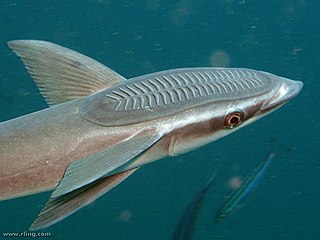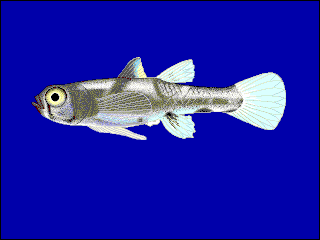Sauries are fish of the family Scomberesocidae. There are two genera, each containing two species. The name Scomberesocidae is derived from scomber and the Latin esox meaning pike.

Ruanoho is a genus of triplefin blennies. It is known from the southwestern Pacific Ocean off New Zealand. The generic name is a compound noun derived from the Māori rua meaning either "fish" or "hole" and noho meaning to "dwell" which refers to the habit of the species in this genus to shelter under rocks or within crevices.
George Sprague Myers was an American ichthyologist who spent most of his career at Stanford University. He served as the editor of Stanford Ichthyological Bulletin as well as president of the American Society of Ichthyologists and Herpetologists. Myers was also head of the Division of Fishes at the United States National Museum, and held a position as an ichthyologist for the United States Fish and Wildlife Service. He was also an advisor in fisheries and ichthyology to the Brazilian Government.

Belone is a genus of needlefish common in brackish and marine waters. It is one of ten genera in the family Belonidae.

Echeneis is a genus of fish in the family Echeneidae, the remoras. The genus is distributed in the Atlantic, Pacific and Indian Oceans.
Rhabdoblennius is a genus of combtooth blennies found in the Pacific Ocean, mostly in the western Pacific. The name of this genus is derived from the Greek word rhabdos meaning "stick" or "rod" and blennius meaning "mucus", referring to the absence of scales on the body of blennies.

Auchenionchus is a genus of labrisomid blennies endemic to the Pacific waters off of Chile.
Onuxodon is an Indo-Pacific genus of pearlfishes from the family Carapidae. The generic name is derived from the Greek onyx meaning "claw" and odon meaning "tooth", referring to the sharp fang like teeth of Onuxodon parvibrachium. Species in this genus are distributed from South Africa to Hawaii. They live commensally with molluscs. The three currently recognized species are:

The needletooth cusk is a species of cusk-eel found in the Indian and the western Pacific Ocean where it occurs at depths of 1,000 to 1,750 metres. This species grows to a length of 21.5 centimetres (8.5 in) SL. It is the only known species of its genus The generic name is a compound of the Greek epetrion meaning "needle" and odous meaning "tooth", while the specific name honours the English ichthyologist Norman Bertram “Freddy” Marshall (1915-1996) who worked on deep sea fishes as the British Museum.

Tylosurus is a genus of needlefish, one of ten in the family Belonidae. They are found worldwide in tropical and warmer temperate seas and two species have been recorded as Lessepsian migrants in the eastern Mediterranean Sea.

Fodiator is a genus of flying fishes. It is the only genus in the subfamily Fodiatorinae.
Scomberesox is a genus of sauries. It is one of two in the family Scomberesocidae. The generic name Scomberesox is a compound of scomber and the Latin esox meaning pike.

Cubanichthys is a small genus of pupfishes endemic to the Caribbean Islands of Cuba and Jamaica. The name of this genus is a compound of Cuba, where the genus was thought to be endemic until C. pengellyi was placed in the genus, and the Greek word for fish, ichthys.
Adelotremus is a small genus of combtooth blennies which are found in the Indo-Pacific region. The name of the genus is a compound of the Greek Adelos meaning "concealed" and trema meaning "hole", this was coined to reflect that the type of Adelotremus leptus was discovered hiding in a tube made by a polychaete.

Acanthocepola is a genus of marine ray-finned fishes belonging to the family Cepolidae the bandfishes. They are native to the Indian Ocean and the western Pacific Ocean.

Pandaka is a genus of fish in the goby subfamily, Gobionellinae, native to fresh, brackish and marine waters of Asia and the western Pacific Ocean. Some species in the genus are among the smallest fish in the world; the male P. pygmaea can be just 9 mm (0.35 in) in standard length at maturity.

Mendosoma is a genus of marine ray finned fish belonging to the family Latridae, the trumpeters.
The panatela silverside is a species of reef-dwelling silverside from the subfamily Atherinomorinae which is found in the southwest Pacific Ocean. This species grows to 11 cm (4.3 in) in total length and is of minor importance to commercial fisheries. This species is the only species in the genus Stenatherina, although some authorities place it in the genus Hypoatherina. This species was described by David Starr Jordan and Robert Earl Richardson as Atherina panatela with the type locality given as Calayan Island in the Philippines. The specific name is the Spanish word for a long, thin cigar and is presumed to be a reference to the elongated, slender body of this fish.
The whitechin surgeonfish is a species of marine ray-finned fish belonging to the family Acanthuridae, the surgeonfishes, unicornfishes and tangs. It is endemic to the waters of the western Pacific Ocean in the Philippines.
Helen K. Larson is an ichthyologist who specialises in the fishes of the Indo-Pacific.










